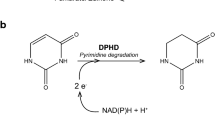Summary
Subcloning of DNA fragments from the gene coding for yeast adenylate cyclase has permitted, after complementation studies in S. cerevisiae cdc35 mutants as well as E. coli cya mutants, to identify the sequence coding for the catalytic domain of the protein. No homology is found between the yeast cyclase catalytic domain and the homologous domain found in E. coli adenylate cyclase. Analysis by Northern blotting of yeast polyA mRNA has shown the existence of multiple transcriptional products of the gene. A putative origin of a major transcript (3.5 kb) would allow synthesis of a ca. 100,000 dalton protein exhibiting cyclase activity in its carboxy terminal domain, and having 7 repeats of 17 amino acids at its amino terminal end. Several noteworthy features, including the possibility of transcriptional control by the general control of amino acids biosynthesis, are present at this putative origin. Data are presented suggesting that a much longer gene product might also be synthesized from the CDC35 gene. Neither the gene organization nor the amino acid sequence of the protein does display any homology with the adenylate cyclase gene and protein of Escherichia coli. This suggests a case of evolutionary convergence for the synthesis of CAMP in prokaryotes and eukaryotes.
Similar content being viewed by others
References
Aiba H, Mori K, Tanaka M, Ooi T, Roy A, Danchin A (1984) Nucleic Acids Res 12:9427–9440
Ammerer G, Hitzeman R, Hagie F, Barta A, Hall B (1981) The functional expression of mammalian genes in yeast. In: Walton LJ (ed) Recombinant DNA. Elsevier, Amsterdam, pp 185–197
Astell C, Ahlstrom-Jonasson L, Smith M, Tatchell K, Nasmyth K, Hall B (1981) Cell 27:15–23
Aviv H, Leder P (1972) Proc Natl Acad Sci USA 69:1408
Beacham I, Schweitzer B, Warrick H, Carbon J (1984) Gene 29:271–279
Beckner SK, Hattori S, Shih TY (1985) Nature (London) 317:71–72
Bennetzen JL, Hall BD (1982) J Biol Chem 257:3026–3031
Breathnach R, Chambon P (1981) Annu Rev Biochem 50:349–383
Burke JM, Breitenberger C, Heckman JE, Dujon B, Rajbhandary UL (1984) J Biol Chem 259:504–511
Fraenkel DG (1985) Proc Natl Acad Sci USA 12:4740–4744
Fröhlich KV, Entran KD, Mecke D (1985) Gene 36:105–111
Hearing P, Shenk T (1983) Cell 33:695–703
Hedegaard L, Danchin A (1985) Mol Gen Genet 847:1–5
Henikoff S, Cohen E (1984) Mol Cell Biol 4:1515–1520
Hinnesbusch AG, Fink GR (1983) J Biol Chem 258:5238–5247
Hochschild A, Irwin N, Ptashne M (1983) Cell 32:319–325
Jacq C, Banroques J, Becam AM, Slonimski PP, Guiso N, Danchin A (1984) EMBO J 3:1567–1572
Kieny M, Lathe R, Lecocq JP (1983) Gene 26:91–99
Laughon A, Scott M (1984) Nature (London) 310:25–31
Leplatois P, Danchin A (1983) Biochimie 65:317–324
Maniatis T, Fritsch E, Sambrook J (1982) Molecular cloning, a laboratory manual. Cold Spring Harbor Laboratory, Cold Spring Harbor, NY
Masson P, Jacquemin JM, Culot M (1984) Ann Microbiol 135:343–351
Matsumoto K, Uno I, Oshima Y, Ishikawa T (1982) Proc Natl Acad Sci USA 79:2355–2359
Matsumoto K, Uno I, Ishikawa T (1984) J Bacteriol 157:277–282
Messing J (1983) Methods Enzymol 101:20–78
Miller JH (1972) Experiments in molecular genetics. Cold Spring Harbor Laboratory, Cold Spring Harbor, NY
Nagamine Y, Reich E (1985) Proc Natl Acad Sci USA 82:4606–4610
Pabo C, Sauer R (1984) Annu Rev Biochem 53:293–321
Pfeuffer E, Dreher RM, Metzger H, Pfeuffer T (1985) Proc Natl Acad Sci USA 82:3086–3090
Rodriguez RL, Tait RC (1983) Recombinant DNA techniques: an introduction. Addison-Wesley, Reading, Mass
Roy A, Danchin A (1982) Mol Gen Genet 188:465–471
Sanger F, Nicklen S, Coulson AR (1981) Proc Natl Acad Sci USA 74:5463–5467
Shepherd J, McGinnis W, Carrasco A, De Robertis E, Gehring W (1984) Nature (London) 310:70–71
Sherman F, Fink G, Hicks J (1979) Methods in yeast genetics. Cold Spring Harbor Laboratory, Cold Sprin Harbor, NY
Uno I, Mitsuzawa H, Matsumoto K, Tanaka K, Oshima T, Ishikawa T (1986) Proc Natl Acad Sci USA (in press)
Author information
Authors and Affiliations
Rights and permissions
About this article
Cite this article
Masson, P., Lenzen, G., Jacquemin, J.M. et al. Yeast adenylate cyclase catalytic domain is carboxy terminal. Curr Genet 10, 343–352 (1986). https://doi.org/10.1007/BF00418405
Received:
Issue Date:
DOI: https://doi.org/10.1007/BF00418405




